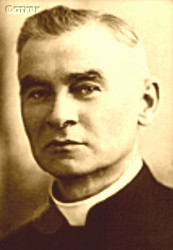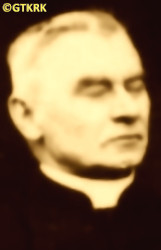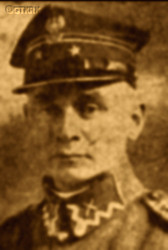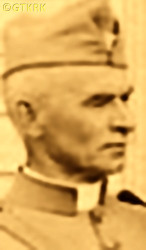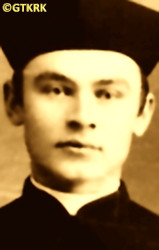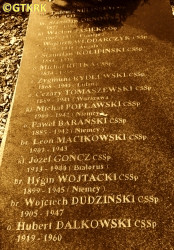Roman Catholic
St Sigismund parish
05-507 Słomczyn
85 Wiślana Str.
Konstancin deanery
Warsaw archdiocese, Poland
full list:
displayClick to display full list

searchClick to search full list by categories
wyświetlKliknij by wyświetlić pełną listę po polsku

szukajKliknij by przeszukać listę wg kategorii po polsku

Martyrology of the clergy — Poland
XX century (1914 – 1989)
personal data
surname
RYDLEWSKI
forename(s)
Sigismund John (pl. Zygmunt Jan)
function
religious cleric
creed
Latin (Roman Catholic) Church RCmore on
en.wikipedia.org
[access: 2014.09.21]
congregation
Congregation of the Holy Spirit under the protection of the Immaculate Heart of Mary CSSpmore on
en.wikipedia.org
[access: 2013.05.19]
(i.e. Holy Ghost Fathers)
diocese / province
Polish Vice‐province CSSp
USA Province CSSp
RC Military Ordinariate of Polandmore on
en.wikipedia.org
[access: 2014.12.20]
honorary titles
Gold „Cross of Merit”more on
en.wikipedia.org
[access: 2019.04.16]
(09.11.1931)
„Cross of Valour”more on
en.wikipedia.org
[access: 2019.04.16]
date and place
of death
02.01.1941

IL Lubininternment camp
today: Krzywiń gm., Kościan pov., Greater Poland voiv., Poland
more on
en.wikipedia.org
[access: 2021.07.18]
details of death
After the end of World War I, in 01.1918 volunteered for the Polish army units forming in Niagara on the Lake in Canada. Accepted as a chaplain. In 08.1918 the units landed in France. In 01.1919 became chaplain of the 4th Polish Rifle Regiment of the Polish Army in France, also known as the Blue Army (Fr. L’Armée bleue), under the command of General Joseph Haller — the Regiment was formed in Italy and in 01.1919 was transported to Lorraine in France, becoming part of the 2nd Polish Rifle Division.
The Army was not fully formed before the end of the military operations of World War I, and in 04‐05.1919 was transported to Poland. There, in 05‐06.1919, the Regiment (under the changed name of the 4th Riflemen Regiment) took part in the final phase of the Polish–Ukrainian War of 1918‐1919, pushing the Ukrainians out north–east of Lviv, on the Zhuzhel–Busk route.
On 27.05.1919, the Regiment was transferred west, to the Dąbrowa Basin, where it protected the Polish–German demarcation line, recognized by the Treaty of Versailles a month later on 27.06.1919 as the temporary border of the Polish state. Since the fate of Upper Silesia had not been determined — the Treaty of Versailles decided to hold a referendum in its area — the Germans took a number of actions aimed at disrupting the process of marking the border, making many provocations towards the Poles. Was there until 09.09.1919 (the Regiment was then renamed as the 46th Borderland Riflemen Regiment — along with the entire Blue Army, it was formally incorporated into the Polish Army on 01.09.1919).
Became then chaplain of the 11th Infantry Division (former 2nd Polish Rifle Division), titular military parish priest.
Three months later, in 12.1919, prob. became chaplain of the Pomeranian Front of the Polish Army, formed on 19.10.1919 under the command of General Haller, which included the 11th Division, and titular military dean. On 19.01.1920, the Pomeranian Front crossed the border of Pomerania — awarded to Poland in the Treaty of Versailles, which came into force on 10.01.1920, after the necessary ratifications — to take it over and formally annex it to Poland. The culmination of the action was the so‐called „Poland's wedding to the sea”, on 10.02.1920 in Puck.
On 23.03.1920, the Pomeranian Front was disbanded and its command was transformed into the command of the 1st Army. On 25.03.1920, became its chaplain and titular military dean. The Polish–Russian War of 1919‐1921 was underway and the 1st Army was sent to the Lithuanian–Belarusian Front. It defended the northern line of the Front, from the border with Latvia and the Dvina River to the sources of the Berezina River, including along the Auta River and the Dvina tributary — the Dzisna. There it took part in defensive actions during the 1st Russian offensive, which began on c. 15.05.1920, and from there it began to withdraw during the great Russian offensive that started on 04.07.1920. In heavy fighting — through Hlybokaye, Vilnius, Grodno, Białystok, which fell on 28.07.1920 — surrendering subsequent lands to the Russians, the Army withdrew westwards towards Warsaw.
And then, on 01.08.1920 — during the battle for Łomża on the Narew — became chaplain of the 3rd Army, its titular dean. The 3rd Army, part of the Polish Central Front, was regrouping at the time — in connection with the planned counteroffensive, which began on c. 15.08.1920 with the great Battle of Warsaw (known as the „Miracle on the Vistula”) — taking up cover positions in the Chełm region and the Lublin region, between the Wieprz and Bug rivers. On 11.08.1920, the battle for Chełm Lubelski began, ending on 18.08.1920 with a Polish victory and the expulsion of the Russians beyond the Bug. This delayed the arrival of Russian reinforcements in the north, where the Russians had to face a Polish counterattack launched from the Wieprz River. The culmination of these cover battles of Polish counterattack was the Battle of Komarovo on 21.08.1920, in which the 1st Cavalry Division, part of the 3rd Army, defeated the Russian Rus. Первая Конная армия (Eng. 1st Cavalry Army) under the command of Gen. Semyon Budyonny — „the combat power of Budyonny’s 1st Cavalry Army was irrevocably broken” (Wikipedia).
During these events, as dean of the 3rd Army, ministered in a field hospital in Lublin.
After the Russian defeat near Warsaw, the pursuit of the retreating Russians began. The 3rd Army, among others, captured Kovel in Volyn, Sokal, Brody, Berestechko and Kremenets in the Ukraine. A unit of the 3rd Army also captured Pinsk in Polesye on 26.09.1920. Finally, one of its divisions, under the command of General Lucien Żeligowski, after faking a mutiny, captured Vilnius on 09.10.1920, retaking the city from the Lithuanians. The 3rd Army, formally not involved, covered General Żeligowski's action.
On 09.12.1920, the command of the 3rd Army was disbanded and then, on 20.12.1920, at own request, was demobilized and transferred to the reserve of the Polish Army.
After German and Russian invasion of Poland in 09.1939 and start of the World War II, after start of German occupation, arrested and interned by the Germans on 02.11.1939 in Puszczykowo.
Next in the spring of 1940 transferred to IL Lond transit camp in Ląd on Warta river.
From there moved to IL Chludowo transit camp in Chludowo.
According to some source also held in IL Görchen transit camp in Goruszki.
Finally at the end of 1940 transported to IL Lubin transit camp in Lubiń where perished.
cause of death
extermination
perpetrators
Germans
sites and events
IL LubinClick to display the description, IL GörchenClick to display the description, IL ChludowoClick to display the description, IL LondClick to display the description, Reichsgau WarthelandClick to display the description, «Intelligenzaktion»Click to display the description, Ribbentrop‐MolotovClick to display the description, Pius XI's encyclicalsClick to display the description, Polish‐Russian war of 1919‐1921Click to display the description, Polish‐Ukrainian war of 1918‐1919Click to display the description
date and place
of birth
01.05.1868

Książ Wielkopolskitoday: Książ Wielkopolski gm., Śrem pov., Greater Poland voiv., Poland
more on
en.wikipedia.org
[access: 2020.11.27]
parents
RYDLEWSKI John
🞲 ?, ? — 🕆 ?, ?

KOPCZYŃSKA Victoria
🞲 ?, ? — 🕆 ?, ?
religious vows
15.08.1893 (temporary)
09.06.1896 (permanent)
presbyter (holy orders)
ordination
28.10.1892

Orlytoday: Créteil arr., Val‐de‐Marne dep., Île‐de‐France reg., France
more on
en.wikipedia.org
[access: 2022.12.10]
RC chapelmore on
en.wikipedia.org
[access: 2022.12.10] (in Holy Ghost Fathers CSSp Congregation's house, i.e. „Château Grignon”)
positions held
1933 – 1939
superior — Puszczykowotoday: Puszczykowo urban gm., Poznań pov., Greater Poland voiv., Poland
more on
en.wikipedia.org
[access: 2021.07.25] ⋄ Congregation's house, Spiritans CSSp — also: master of novitiate
1921 – 1932
friar — Bydgoszcztoday: Bydgoszcz city pov., Kuyavia‐Pomerania voiv., Poland
more on
en.wikipedia.org
[access: 2021.06.20] ⋄ Congregation's house, Spiritans CSSp — director and co‐founder of „Gen. Joseph Haller's St Joseph House for the sons of defenders of the homeland” orphanage; also: co‐founder of the house
1925 – 1926
Provincial — Polish Vice–province, Spiritans CSSp
01.09.1919 – 20.12.1920
RC military chaplain — Polish Armed Forces — 09.09.1919‐12.1919 of the 11th Infantry Division, as titular military pastor; 12.1919‐23.03.1920 of the Pomeranian Front, as titular military dean; 23.03.1920‐01.08.1920 of the 1st Army, as titular military dean; 01.08.1920‐20.12.1920of the 3rd Army, as titular military dean; formally accepted into the Polish Army as a chaplain by decree L. 2238 of the Commander‐in‐Chief of 30.07.1920; demobilized and transferred to the Polish Army reserve on 20.12.1920, with the rank of lieutenant colonel
08.1918 – 01.09.1919
RC military chaplain — Polish Army in France (known also as „Blue Army” (fr. „L’Armée bleue”)), Polish Armed Forces — 4th Polish Rifle Regiment, renamed in 05.1919 as the 4th Infantry Rifle Regiment
01.1918 – 08.1918
RC military chaplain — Niagara‐on‐the‐Laketoday: Niagara reg., Ontario prov., Canada ⋄ training camp, Polish Armed Forces in Canada
1914 – 1918
parish priest — Pittsburghtoday: Allegheny Cou., Pennsylvania US‐PA state, United States of America
more on
en.wikipedia.org
[access: 2022.05.02] ⋄ Immaculate Heart of the Blessed Virgin Mary RC parish
1912 – 1914
professor — Ferndaletoday: Norwalk, Fairfield Cou., Connecticut US‐CT state, United States of America
more on
en.wikipedia.org
[access: 2022.12.10] ⋄ Higher Theological Seminary i.e. Scholasticate, Congregation's house, Spiritans CSSp — lecturer in moral theology; also: house treasury officer / procurator, novice master
1906 – 1912
parish priest — Mount Carmeltoday: Northumberland Cou., Pennsylvania US‐PA state, United States of America
more on
en.wikipedia.org
[access: 2022.12.10] ⋄ St Joseph RC parish
1905 – 1906
rector — Cornwells Heightstoday: part of Bensalem Township, Bucks Cou., Pennsylvania US‐PA state, United States of America
more on
en.wikipedia.org
[access: 2022.12.10] ⋄ Apostolic Missionary College — Higher Theological Seminary i.e. Scholasticate, Congregation's house, Spiritans CSSp
10.1904 – 03.1905
director — Bobrektoday: Chełmek gm., Oświęcim pov., Lesser Poland voiv., Poland
more on
en.wikipedia.org
[access: 2021.12.18] ⋄ orphanage — attempt to create a Congregation's house in Galicia (then in the Austro–Hungarian partition of Poland)
1901 – 1904
professor — Cornwells Heightstoday: part of Bensalem Township, Bucks Cou., Pennsylvania US‐PA state, United States of America
more on
en.wikipedia.org
[access: 2022.12.10] ⋄ Apostolic Missionary College — Higher Theological Seminary i.e. Scholasticate, Congregation's house, Spiritans CSSp — lecturer in moral theology; also: treasury officer / procurator of the American Province of the Congregation, assistance at the construction of the Major Seminary i.e. Scholasticate and minister of the church of St Vincent in Ferndale, and minister of the church in Atkins
1898 – 1901
administrator — Pittsburghtoday: Allegheny Cou., Pennsylvania US‐PA state, United States of America
more on
en.wikipedia.org
[access: 2022.05.02] ⋄ St Stanislav Kostka the Confessor RC parish — deputy parish priest; also: the originator of the Polish orphanage in Emsworth
1897 – 1898
administrator — Pittsburghtoday: Allegheny Cou., Pennsylvania US‐PA state, United States of America
more on
en.wikipedia.org
[access: 2022.05.02] ⋄ Immaculate Heart of the Blessed Virgin Mary RC parish — organizer of the new parish
1893 – 1898
vicar — Pittsburghtoday: Allegheny Cou., Pennsylvania US‐PA state, United States of America
more on
en.wikipedia.org
[access: 2022.05.02] ⋄ St Stanislav Kostka the Confessor RC parish
1892 – 15.08.1893
novitiate — Ferndaletoday: Norwalk, Fairfield Cou., Connecticut US‐CT state, United States of America
more on
en.wikipedia.org
[access: 2022.12.10] ⋄ Congregation's house, Spiritans CSSp — prob.
till 1892
student — Chevillytoday: Chevilly‐Larue, L'Haÿ‐les‐Roses arr., Val‐de‐Marne dep., Île‐de‐France reg., France
more on
en.wikipedia.org
[access: 2022.12.10] ⋄ philosophy and theology, Theological Seminary (Scholasticate), Spiritans CSSp
18.04.1885
accession — (United States of America territory)today: United States of America
more on
en.wikipedia.org
[access: 2022.08.05] ⋄ Spiritans CSSp — start of postulate
others related
in death
TOMASZEWSKIClick to display biography Caesar
sites and events
descriptions
IL Lubin: The Gestapo District Office in Poznań issued on 13.12.1939 executive instruction Ref. IIB No. 406/39 Tgb. No. 3045/39, ordering: „Based on the regulation of the Germ. Höherer SS‐ und Polizeiführer (Eng. Higher Commander of the SS and Police) [of the Germ. Warthegau (Eng. Greater Poland)] province of 12.11.1939 [SS‐Gruppenführer Wilhelm Koppe], apart from Poles and Jews, also Catholic clergy will be expelled. Action against this group of people should be carried out in such a way that internment and transport are separate […] C. 80% of Catholic clergy are expected to be expelled. The selection based on political threat posed. Internees cannot be placed in regular transit camps due to the possibility of international protest. Catholic clergy should be interned in men's monasteries and held there till mass transportation out”. And so at the Benedictine abbey in Lubiń near Kościan, at the beginning of 1940, the Germans — Germ. Geheime Staatspolizei (Eng. Secret State Police), i.e. Gestapo — organized an temporary Germ. „Internierungslager” (Eng. „Internment camp”) IL Lubin for priests and friars from Greater Poland (dated from 15.02.1940, although the Germans brought several priests to the abbey earlier). E.g. in 04.1941 Franciscan friars from Goruszki monastery were brought in. In total, 104 clergymen were held in the monastery. On 06.10.1941, as part of the third great operation of arrests of the Polish clergy of Greater Poland — more precisely, from the Germ. Warthegau occupational province — all interned priests were transported to the KL Dachau concentration camp. Religious brothers were allowed to return to their family homes. The monastery was turned into an old people's home, and later as a training center for national‐socialist German youth, Germ. „Hitler‐Jugend” (Eng. „Hitler youth”). Rich library collections and other goods were plundered. The Benedictines returned to the monastery on 25.01.1945, after the German defeat. (more on: www.benedyktyni.netClick to attempt to display webpage
[access: 2013.08.10], pl.wikipedia.orgClick to attempt to display webpage
[access: 2013.08.10])
IL Görchen: The Franciscan monastery „Goruszki” in Miejska Górka, c. 10 km from Rawicz, became a place of internment for Polish priests and friars from surrounding counties (including Leszno County). On 15.02.1940 became, officers of the murderous Germ. Geheime Staatspolizei (Eng. Secret State Police), i.e. Gestapo, entered the monastery, bringing the first 18 priests to be interned and demanded that the Franciscan Fathers took over responsibility for their stay in the monastery, forbidding them and the friars to leave the monastery. The monastery became de facto Germ. „Internierungslager” (Eng. „internment camp”) IL Görchen. On 01‐02.04.1941 the Germans entered the monastery by force and transferred all the internees — priests and monks – to the internment camp in Lubiń. They turned the monastery buildings into a prison — a branch of the prison in Rawicz, i.e. Germ. Außenkommando Tbc‐Station (Eng. external ward for patients with tuberculosis). It became the place of execution of hundreds of Poles — today there are 453 graves of the murdered in the monastery cemetery. The prison functioned until 1945 and the fall of national–socialist Germany. (more on: www.franciszkanie-goruszki.plClick to attempt to display webpage
[access: 2021.12.19])
IL Chludowo: The Gestapo District Office in Poznań issued on 13.12.1939 executive instruction Ref. IIB No. 406/39 Tgb. No. 3045/39, ordering: „Based on the regulation of the Germ. Höherer SS‐ und Polizeiführer (Eng. Higher Commander of the SS and Police) [of the German province of Warthegau (Eng. Greater Poland)] of 12.11.1939 [SS‐Gruppenführer Wilhelm Koppe], apart from Poles and Jews, also Catholic clergy will be expelled. Action against this group of people should be carried out in such a way that internment and transport are separate […] C. 80% of Catholic clergy are expected to be expelled. The selection based on political threat posed. Internees cannot be placed in regular transit camps due to the possibility of international protest. Catholic clergy should be interned in men's monasteries and held there till mass transportation out”. One of them was the house of the Divine Word Missionaries SVD in Chludowo, c. 20 km north of Poznań, purchased by the Congregation in 1934 from one of the most outstanding Polish politicians and publicists, Roman Dmowski. The Germans — Germ. Geheime Staatspolizei (Eng. Secret State Police), i.e. Gestapo — on 25.01.1940 established there the Germ. „Internierungslager” (Eng. „internment camp”) IL Chludowo for the Catholic clergy. All the friars present were interned, effectively deprived of means of subsistence, and over 60 arrested priests from nearby parishes of the Poznań and Gniezno archdioceses were transported in. On 22.05.1940, most of them were deported — through the KL Posen concentration camp — to the KL Dachau concentration camp in Bavaria. The facility was then handed over to the German Wehrmacht army, its XXI Wehrkreis (Eng. Military District), covering Greater Poland occupied by the Germans, and prob. was still used as a IL XXI Chludowo POW camp for Poles. In 1943, the camp was liquidated and the Germans established an observation point for the German Luftwaffe Air Force in the buildings. (more on: pl.wikipedia.orgClick to attempt to display webpage
[access: 2012.11.23])
IL Lond: The Gestapo District Office in Poznań issued on 13.12.1939 executive instruction Ref. IIB No. 406/39 Tgb. No. 3045/39, ordering: „Based on the regulation of the Germ. Höherer SS‐ und Polizeiführer (Eng. Higher Commander of the SS and Police) [of the German province of Warthegau (Eng. Greater Poland)] of 12.11.1939 [SS‐Gruppenführer Wilhelm Koppe], apart from Poles and Jews, also Catholic clergy will be expelled. Action against this group of people should be carried out in such a way that internment and transport are separate […] C. 80% of Catholic clergy are expected to be expelled. The selection based on political threat posed. Internees cannot be placed in regular transit camps due to the possibility of international protest. Catholic clergy should be interned in men's monasteries and held there till mass transportation out”. And so in 1940‐1941, in a formerly Cistercian priory and monastery (today Salesian Institute) in Ląd on Warta river Germans set‐up a transit Germ. „Internierungslager” (Eng. „Internment camp”) for Polish priests and religious, from Włocławek, Gniezno, Warszawa, Poznań, Płock and Częstochowa dioceses and religious and monks from a number of congregations. Approx. 152 religious (70 till 03.04.1941 and 82 in 06‐28.10.1941) were held there prior to being sent to KL Dachau concentration camp. After the deportation, the Germans organized a training center for the German National Socialist youth wing, Germ. „Hitler‐Jugend” (Eng. „Hitler youth”), in the abbey. (more on: pl.wikipedia.orgClick to attempt to display webpage
[access: 2013.08.10], yadda.icm.edu.plClick to attempt to display webpage
[access: 2016.03.14])
Reichsgau Wartheland: After the Polish defeat in the 09.1939 campaign, which was the result of the Ribbentrop‐Molotov Pact and constituted the first stage of World War II, and the beginning of German occupation in part of Poland (in the other, eastern part of Poland, the Russian occupation began), the Germans divided the occupied Polish territory into five main regions (and a few smaller). The largest one was transformed into Germ. Generalgouvernement (Eng. General Governorate), intended exclusively for Poles and Jews and constituting part of the so‐called Germ. Großdeutschland (Eng. Greater Germany). Two were added to existing German provinces. From two other separate new provinces were created. Greater Poland region was one of them, incorporated into Germany on 08.10.1939, by decree of the German leader Adolf Hitler (formally came into force on 26.10.1939), and on 24.01.1940 transformed into the Germ. Reichsgau Wartheland (Eng. Wartheland Reich Province), in which the law of the German state was to apply. The main axis of the policy of the new province, the territory of which the Germans recognized as the Germ. „Ursprünglich Deutsche” (Eng. „natively German”), despite the fact that 90% of its inhabitants were Poles, was Germ. „Entpolonisierung” (Eng. „Depolonisation”), i.e. forced Germanization. C. 100,000 Poles were murdered as part of the Germ. „Intelligenzaktion”, i.e. extermination of Polish intelligentsia and ruling classes. C. 630,000 were forcibly resettled to the Germ. Generalgouvernement, and their place taken by the Germans brought from other areas occupied by Germany (e.g. the Baltic countries, Bessarabia, Bukovina, etc.). Poles were forced to sign the German nationality list, the Germ. Deutsche Volksliste DVL. As part of the policy of „Ohne Gott, ohne Religion, ohne Priesters und Sakramenten” (Eng. „No God, no religion, no priest or sacrament”) most Catholic priests were arrested and sent to concentration camps. All schools teaching in Polish, Polish libraries, theaters and museums were closed. Polish landed estates confiscated. To further reduce the number of the Polish population, Poles were sent to forced labor deep inside Germany, and the legal age of marriage for Poles was increased (25 for women, 28 for men). The German state office, Germ. Rasse‐ und Siedlungshauptamt (Eng. Main Office of Race and Settlement) RuSHA, under the majesty of German law, abducted several thousand children who met specific racial criteria from Polish families and subjected them to forced Germanization, handing them over to German families. After the end of hostilities of World War II, the overseer of this province, the Germ. Reichsstatthalter (Eng. Reich Governor) and the Germ. Gauleiter (Eng. district head) of the German National Socialist Party, Arthur Karl Greiser, was executed. (more on: en.wikipedia.orgClick to attempt to display webpage
[access: 2024.06.21])
«Intelligenzaktion»: German: «Intelligenzaktion» (English: „Intelligence Action”) — a German program of extermination of the Polish elite, mainly the intelligentsia and leadership layers, carried out from the beginning of the occupation in w 09.1939 to 04.1940, mainly in territories directly annexed to Germany, but also in the so‐called Germ. Generalgouvernement (Eng. General Governorate), where it was called «AB‐aktion». In the first phase, immediately after the beginning of the German occupation, during military operations carried out by the Germ. Wehrmacht (Eng. Armed Forces) and the genocidal units of the Germ. Einsatzgruppen (Eng. Operational Groups) of the Germ. Sicherheitspolizei (Eng. Security Police), i.e. SiPo, and Germ. Sicherheitsdienst des Reichsführers SS (Eng. Security Service of the Reichsführer SS), i.e. SD, organized by the Germ. Reichssicherheitshauptamt (Eng. Reich Main Security Office), i.e. RSHA, which followed the troops, carried out under the Germ. Unternehmen „Tannenberg” (Eng. Operation „Tannenberg”) — based on the so‐called Germ. Sonderfahndungsliste (Eng. Special Wanted Lists), i.e. proscription lists of Poles considered particularly dangerous to the Third Reich, prepared by the Zentralstelle II/P (Polen) unit of the German RSHA. Later, implemented by the German civilian occupation authorities and the genocidal unit of the Germ. Volksdeutscher Selbstschutz (Eng. Ethnic Germans Self‐Defense), whose members were Germ. Volksdeutsche (Eng. Ethnic Germans), i.e. representatives of the German minority in Poland. According to various sources, these lists, at the beginning of 09.1939, could have contained the details of 61,000—88,000 „dangerous” Poles — although these figures cannot be confirmed. In total, during this genocide, c. 50,000 teachers, Catholic priests, representatives of the landed gentry, freelancers, social and political activists, and retired military personnel were systematically and methodically murdered. Another 50,000 were sent to concentration camps, where only a negligible percentage survived. (more on: en.wikipedia.orgClick to attempt to display webpage
[access: 2014.10.04])
Ribbentrop‐Molotov: Genocidal Russian‐German alliance pact between Russian leader Joseph Stalin and German leader Adolf Hitler signed on 23.08.1939 in Moscow by respective foreign ministers, Mr. Vyacheslav Molotov for Russia and Joachim von Ribbentrop for Germany. The pact sanctioned and was the direct cause of joint Russian and German invasion of Poland and the outbreak of the World War II in 09.1939. In a political sense, the pact was an attempt to restore the status quo ante before 1914, with one exception, namely the „commercial” exchange of the so‐called „Kingdom of Poland”, which in 1914 was part of the Russian Empire, fore Eastern Galicia (today's western Ukraine), in 1914 belonging to the Austro‐Hungarian Empire. Galicia, including Lviv, was to be taken over by the Russians, the „Kingdom of Poland” — under the name of the General Governorate — Germany. The resultant „war was one of the greatest calamities and dramas of humanity in history, for two atheistic and anti‐Christian ideologies — national and international socialism — rejected God and His fifth Decalogue commandment: Thou shall not kill!” (Abp Stanislav Gądecki, 01.09.2019). The decisions taken — backed up by the betrayal of the formal allies of Poland, France and Germany, which on 12.09.1939, at a joint conference in Abbeville, decided not to provide aid to attacked Poland and not to take military action against Germany (a clear breach of treaty obligations with Poland) — were on 28.09.1939 slightly altered and made more precise when a treaty on „German‐Russian boundaries and friendship” was agreed by the same murderous signatories. One of its findings was establishment of spheres of influence in Central and Eastern Europe and in consequence IV partition of Poland. In one of its secret annexes agreed, that: „the Signatories will not tolerate on its respective territories any Polish propaganda that affects the territory of the other Side. On their respective territories they will suppress all such propaganda and inform each other of the measures taken to accomplish it”. The agreements resulted in a series of meeting between two genocidal organization representing both sides — German Gestapo and Russian NKVD when coordination of efforts to exterminate Polish intelligentsia and Polish leading classes (in Germany called «Intelligenzaktion», in Russia took the form of Katyń massacres) where discussed. Resulted in deaths of hundreds of thousands of Polish intelligentsia, including thousands of priests presented here, and tens of millions of ordinary people,. The results of this Russian‐German pact lasted till 1989 and are still in evidence even today. (more on: en.wikipedia.orgClick to attempt to display webpage
[access: 2015.09.30])
Pius XI's encyclicals: Facing the creation of two totalitarian systems in Europe, which seemed to compete with each other, though there were more similarities than contradictions between them, Pope Pius XI issued in 03.1937 (within 5 days) two encyclicals. In the „Mit brennender Sorge” (Eng. „With Burning Concern”) published on 14.03.1938, condemned the national socialism prevailing in Germany. The Pope wrote: „Whoever, following the old Germanic‐pre‐Christian beliefs, puts various impersonal fate in the place of a personal God, denies the wisdom of God and Providence […], whoever exalts earthly values: race or nation, or state, or state system, representatives of state power or other fundamental values of human society, […] and makes them the highest standard of all values, including religious ones, and idolizes them, this one […] is far from true faith in God and from a worldview corresponding to such faith”. On 19.03.1937, published „Divini Redemptoris” (Eng. „Divine Redeemer”), in which criticized Russian communism, dialectical materialism and the class struggle theory. The Pope wrote: „Communism deprives man of freedom, and therefore the spiritual basis of all life norms. It deprives the human person of all his dignity and any moral support with which he could resist the onslaught of blind passions […] This is the new gospel that Bolshevik and godless communism preaches as a message of salvation and redemption of humanity”… Pius XI demanded that the established human law be subjected to the natural law of God , recommended the implementation of the ideal of a Christian state and society, and called on Catholics to resist. Two years later, National Socialist Germany and Communist Russia came together and started World War II. (more on: www.vatican.vaClick to attempt to display webpage
[access: 2023.05.28], www.vatican.vaClick to attempt to display webpage
[access: 2023.05.28])
Polish‐Russian war of 1919‐1921: War for independence of Poland and its borders. Poland regained independence in 1918 but had to fight for its borders with former imperial powers, in particular Russia. Russia planned to incite Bolshevik‐like revolutions in the Western Europe and thus invaded Poland. Russian invaders were defeated in 08.1920 in a battle called Warsaw battle („Vistula river miracle”, one of the 10 most important battles in history, according to some historians). Thanks to this victory Poland recaptured part of the lands lost during partitions of Poland in XVIII century, and Europe was saved from the genocidal Communism. (more on: en.wikipedia.orgClick to attempt to display webpage
[access: 2014.12.20])
Polish‐Ukrainian war of 1918‐1919: One of the wars for borders of the newly reborn Poland. At the end of 1918 on the former Austro‐Hungarian empire’s territory, based on the Ukrainian military units of the former Austro‐Hungarian army, Ukrainians waged war against Poland. In particular attempted to create foundation of an independent state and attacked Lviv. Thanks to heroic stance of Lviv inhabitants, in particular young generation of Poles — called since then Lviv eaglets — the city was recaptured by Poles and for a number of months successfully defended against furious Ukrainian attacks. In 1919 Poland — its newly created army — pushed Ukrainian forces far to the east and south, regaining control over its territory. (more on: en.wikipedia.orgClick to attempt to display webpage
[access: 2017.05.20])
sources
personal:
www.duchacze.plClick to attempt to display webpage
[access: 2012.12.28], www.wtg-gniazdo.orgClick to attempt to display webpage
[access: 2013.08.10], ordynariat.wp.mil.plClick to attempt to display webpage
[access: 2015.09.30], pl.wikipedia.orgClick to attempt to display webpage
[access: 2013.08.10]
original images:
www.duchacze.plClick to attempt to display webpage
[access: 2012.12.28], duchacze.plClick to attempt to display webpage
[access: 2019.05.30], ordynariat.wp.mil.plClick to attempt to display webpage
[access: 2015.09.30], forum.odkrywca.plClick to attempt to display webpage
[access: 2024.12.13], swietygabriel.pl.tlClick to attempt to display webpage
[access: 2024.12.13], duchacze.plClick to attempt to display webpage
[access: 2020.07.31]
LETTER to CUSTODIAN/ADMINISTRATOR
If you have an Email client on your communicator/computer — such as Mozilla Thunderbird, Windows Mail or Microsoft Outlook, described at WikipediaPatrz:
en.wikipedia.org, among others — try the link below, please:
LETTER to CUSTODIAN/ADMINISTRATORClick and try to call your own Email client
If however you do not run such a client or the above link is not active please send an email to the Custodian/Administrator using your account — in your customary email/correspondence engine — at the following address:

giving the following as the subject:
MARTYROLOGY: RYDLEWSKI Sigismund John
To return to the biography press below:
 Click to return to biography
Click to return to biography








